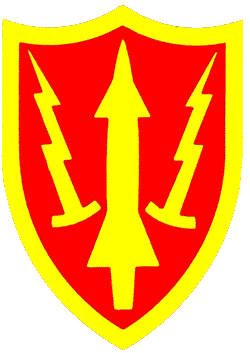 |
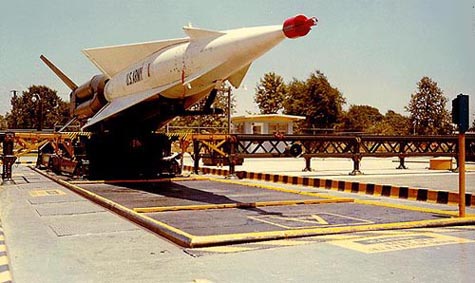 |
 |
| Nike Base Wisconsin’s Nuclear Arsenal |
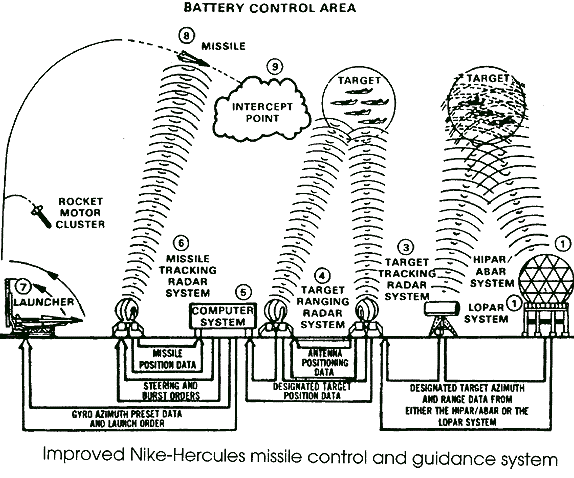 An often overlooked bit of
nuclear weaponry is the Nike series of surface to air missiles.
There were something like 300 Nike bases scattered throughout
the country, surrounding the forty military, population, and
industrial centers thought to be the most likely targets of
nuclear attack by the Soviets. These were tactical, rather than
strategic weapons, due to their limited range, and were purely
defensive.
An often overlooked bit of
nuclear weaponry is the Nike series of surface to air missiles.
There were something like 300 Nike bases scattered throughout
the country, surrounding the forty military, population, and
industrial centers thought to be the most likely targets of
nuclear attack by the Soviets. These were tactical, rather than
strategic weapons, due to their limited range, and were purely
defensive.
Though associated with the Cold War, the Nike system had
it’s roots in WWII, as a defense against possible attacks by
anticipated German jet powered, long range bombers. Against such
aircraft, the existing AA guns, and artillery would have been
nearly useless. Development was complex, and the war had ended
while the system was being designed, so the Nike
was not fully developed and deployed until 1953, when it
was put in place to protect us against our former allies in that
conflict, the Russians.
The original system had a range of around 30 miles, and
even the latest developments were never able to attain a range
of more than 520 miles. These were purely tactical weapons,
despite their eventual use of nuclear warheads. Early nuclear
tipped Nikes had an adjustable yield (up to 40kt) warhead, while
the final version had a 5mt thermonuclear warhead.
These were pretty much intended to be a weapon of last
resort to knock down bombers, which had broken through all
other defenses and were within United States territory.
Detonation of a 40kt to 5mt warhead, over a section of the
United States would have had some serious consequences. Still,
it would probably be better than a direct hit on a city, by a
functioning ICBM, or a load of nuclear bombs from
a Soviet bomber.
There were 22 (some say 23) Nike sites ringing the
Chicago – Milwaukee area. Each site was capable of launching
anywhere from 6 to 20 missiles.
Each site was divided into two parts. The launch area was
separate from the radar/control/administrative center, usually
by at least 1000 feet. This was a requirement of the early radar
systems, which could not reliably track the fast moving
missiles at closer distances.
There were eight Nike bases protecting Milwaukee. One
site, M-20, was at the lakefront, and was sold to the city, upon
decommissioning, to become the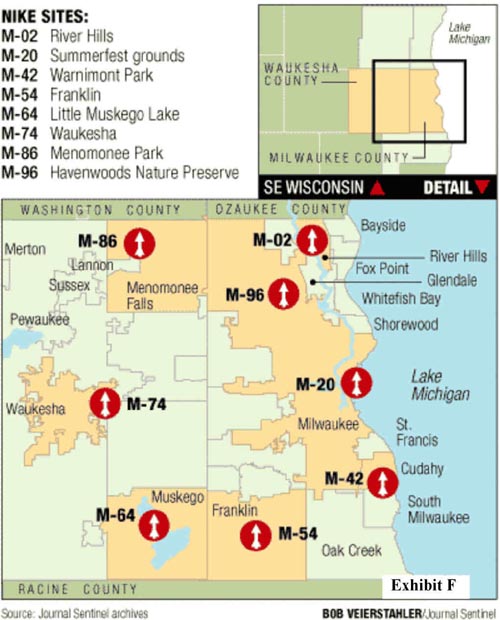 Summerfest grounds. Most of the
others have become housing developments, municipal facilities,
or parks. Site M-74, was deployed in Waukesha, and remains
relatively untouched, though it has not aged well. The
radar/control area is in what is now called Hillcrest Park, just
off of Davidson Road. The launch area is in what is now the
appropriately named Missile Park,
North of
east Broadway, and east of highway 164/59. This site is often
erroneously referred to as site M-47, due to a typo in
Wikipedia, which has been repeated by many researchers, who use
this as their only source of research.
Summerfest grounds. Most of the
others have become housing developments, municipal facilities,
or parks. Site M-74, was deployed in Waukesha, and remains
relatively untouched, though it has not aged well. The
radar/control area is in what is now called Hillcrest Park, just
off of Davidson Road. The launch area is in what is now the
appropriately named Missile Park,
North of
east Broadway, and east of highway 164/59. This site is often
erroneously referred to as site M-47, due to a typo in
Wikipedia, which has been repeated by many researchers, who use
this as their only source of research.
As of March, 2006, the City of Waukesha owns the
property, and there is some interest in turning the site into a
Cold War museum. The control center is a fun place to wander
around in, and there are a number of structures still to be
seen. The launch area is a different story. It has been cleaned
up, graveled, and the magazine elevator doors have been covered
with asphalt, in order to prevent the curious from falls and
injury. Still, it is worth a visit, for those who happen to live
in the area. For those who wish a bit more, there are presently
two restored Nike sites, and a third in the process of
restoration.
The Nike missiles themselves were stored in underground
magazines, until just before launch. At launch, they would be
sent up, between a set of armored doors, via hydraulic elevator,
to be emplaced on the surface mounted rail launcher. A typical
magazine held six to ten missiles. Battery sizes varied. A
launch site could have from one to four launchers, each being
fed by one to four underground magazines. Radar installations
also varied, and there really was no such thing as a “typical”
Nike site.
For it’s entire service life, the Nike system was
operated under the fiction that it was a mobile system. Thus,
even with its missiles stored in underground, concrete
magazines, its launchers mounted in concrete pads, and its large
radars mounted on steel towers, the launch controllers,
communications gear, and radar screens were all mounted in
trailers. These trailers would then generally be housed in a
concrete blast bunker.
Remaining at the Hillcrest Park site are a radar tower, and framework for an antenna, the blast shelter, and the barracks. The buildings are in very good shape; but are being used by the park, and have been modified to better suit their new roles. The tower and framework are in very good shape. Fencing, guard posts, and most other lighter structures are gone, as the area was cleaned up for use as a park.
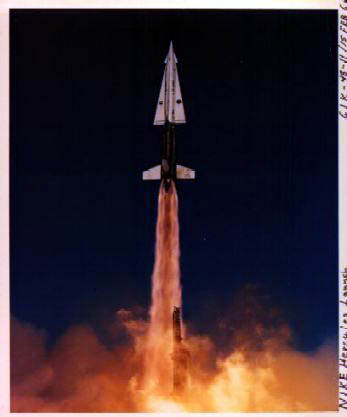 For its day, the Nike system was a marvel. Much of the
technology developed for the Nike is still in use today.
A direct descendant of the old Nike is the modern Patriot
missile system. Though the Nike was the major element of the
Army, Air Defense Command, and took over the major air defense
role, in replacing the old 90mm, 120mm, and 40mm guns, it was
not the only system. The Air force had its BOMARC, and Genie
systems, the one being ground launched, and the other being air
launched. The Air Force had, at this time, just separated from
the Army, to become its own branch of the service, and there was
quite a bit of jealousy and competition, while both sides
attempted to outdo the other and define their own turf. Of the
three systems, the Nike was the longest lived, with some U.S.
sites remaining active until 1984, and some overseas sites
remaining in service until 1992.
For its day, the Nike system was a marvel. Much of the
technology developed for the Nike is still in use today.
A direct descendant of the old Nike is the modern Patriot
missile system. Though the Nike was the major element of the
Army, Air Defense Command, and took over the major air defense
role, in replacing the old 90mm, 120mm, and 40mm guns, it was
not the only system. The Air force had its BOMARC, and Genie
systems, the one being ground launched, and the other being air
launched. The Air Force had, at this time, just separated from
the Army, to become its own branch of the service, and there was
quite a bit of jealousy and competition, while both sides
attempted to outdo the other and define their own turf. Of the
three systems, the Nike was the longest lived, with some U.S.
sites remaining active until 1984, and some overseas sites
remaining in service until 1992.
Though it was probably still a viable system, upon its retirement, and well able to continue its mission, the mission itself had nearly gone away. The original mission of the Nike was to intercept, and destroy incoming high speed, high altitude aircraft. During its initial deployment, in 1952, American was fighting the Korean War, and its most advanced fighter aircraft was the F-86, a straight winged jet, barely able to manage Mach 1. Much of the American and Soviet air forces still relied upon old style prop driven planes. Compared to this, the radar controlled, mach 2.5 Nike was a marvel. By the seventies/eighties, when the Nike was retired, the F-15, and F-16 fighters were leading the way. These mach 2 - 2.5 aircraft were well able to act as interceptors, for any potential enemy bombers. Even this, though, was not the entire story.
Development of the modern ICBM, first by the United States, and then by the USSR, meant that any major attack, from an opposing nuclear power, would likely come from space, with a 20 minute warning, at 15,000 mph. The Patriot missile, and similar systems are being tweaked to counter this type of threat; but for fifty years, there really has been no reliable way to counter the ICBM. Bombers have been relegated to the status of a secondary threat, and are no longer considered to be a first strike weapon, in this type of conflict. Modern laser type weapons are being looked at as a possible solution to the ICBM; but they are still off in the future. The way that the superpowers have been dealing with this threat is to essentially give up, and admit defeat. Rather than attempting to defend ourselves, we have taken great pains to assure any enemy, that an attack on the United States will result in the certain destruction of the attacker. This is the domain of the ICBM, and the SLBM, the so called doomsday weapons, like the Minuteman, Peacekeeper, and Trident missiles. These systems got all of the press, all of the attention, the money, and the status. They also generated most of the fear. These were commanded by the gentleman technocrats of the Air Force, and Navy. This was to be the ultimate in push button warfare.
Still, a crew working a
Nike site, had they ever been required to launch in earnest,
would have been doing so, in order to protect their families,
their nation, and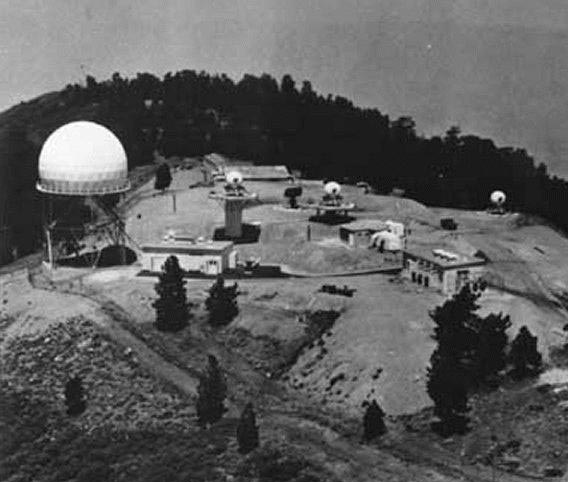 themselves. They would also have known that they might have a chance
to succeed in their mission. The crew of a missile submarine, or
the team working underground in a Minuteman launch center would
have had no such reassurance. In contrast to the Nike operators,
these men would
have known that all was lost, and that their mission of deterrence had
failed. All that would be left for them would be a mission of
vengeance.
themselves. They would also have known that they might have a chance
to succeed in their mission. The crew of a missile submarine, or
the team working underground in a Minuteman launch center would
have had no such reassurance. In contrast to the Nike operators,
these men would
have known that all was lost, and that their mission of deterrence had
failed. All that would be left for them would be a mission of
vengeance.
Fortunately for everyone, neither system was ever used, so in a sense, both succeeded. The Cold War is one that we won, In truth, it is the only war of consequence to have been fought, since WWII, and may even be considered as a bit of an outgrowth of that war, and of the shifting of power which resulted from it. All of the other conflicts, and wars fought since, have been minor theaters of that great, long war, as the superpowers sought advantage for an ultimate showdown which never came.
It is fun to look at these old places now, secure in the knowledge that the threat they were designed to counter, threatens us no more. There are some initiatives to turn old M-74 into a Cold War museum. Several old Nike bases are being restored and opened to the public, in Florida, California, and New Jersey. Most of the others rust and rot. The photo to the right is of a base in the west; but gives a pretty good indication of what old M-74 looked like while it was in service. The pedestal of the tracking tower, and the framework of the HIPAR are pretty easily recognizable. When compared to the photos of the site in its current condition below.
A mile south of the radar site is the launch site. As of this writing it is covered by snow, and is difficult to access, due to the condition of the county roads. I do plan to go there, and photograph the place sometime this summer, and will update this page at that time.
Chances are, if you live in any large metro area, there are some Nike sites scattered around, for you to visit. The sites were strongly built, to survive near misses during a nuclear strike, and would thus be very difficult, and expensive to knock down. So most were left standing. Some have been taken over by The National Guard, others by schools, and municipalities, and a few became parks. Many were just left as they were - abandoned after everything that could be reused was removed. They are out there, their locations are well mapped and easy to find, just waiting to be visited by the urban explorer.
The Site Today|
|
A sign declares this are to be a gift of the U.S. government. The real gift was that this place was never attacked, never destroyed, and stood securely during some pretty insecure times. |
|
|
This plaque was set in place as a sort of memorial to what was built here. These places are little remembered, in part because they performed their job so well. |
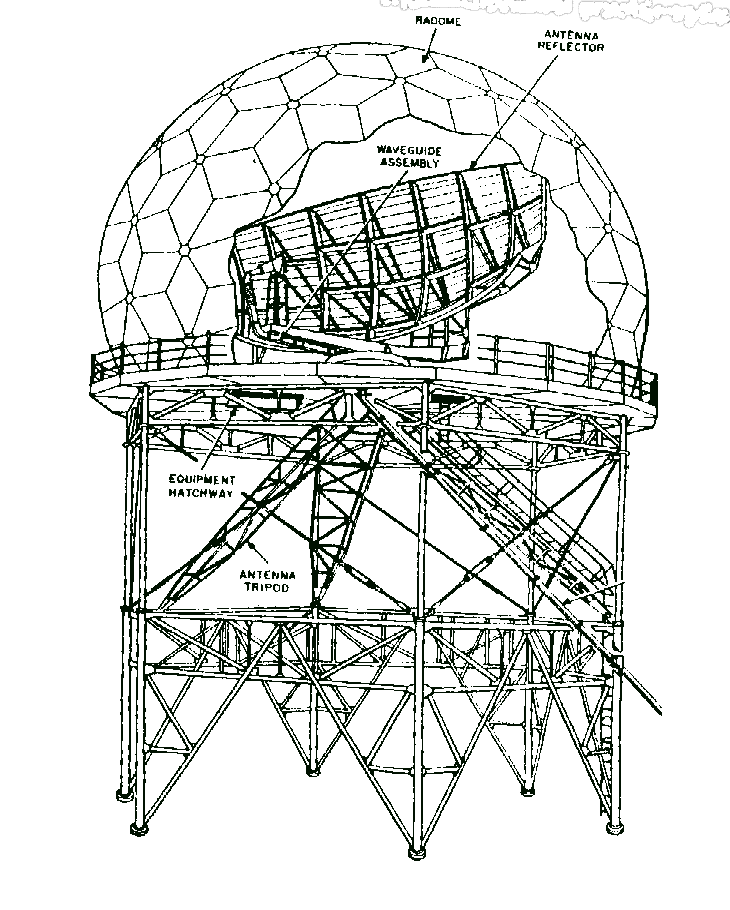 |
Left: A drawing of the Hipar (High Power Acquisition radar) antenna. Like the reset of the Nike components, these were designed under the fiction that this was a portable system. The portable antenna was erected within a steel tower, and protected by a Radom. The radar had a range of 175 miles. Below: What the mounting tower looks like today, over thirty years after removal of the antenna system. |
|
|
|
|
|
|
|
|
Above: The tower for the tracking radar. Left: Access to the platform, of the tracking radar tower. Below: A look at the tracking radar tower, from within the Hipar tower. |
|
|
|
|
|
Left: The blast building, which had formerly held the equipment trailers. |
|
|
A look around back of the blast building. Visible in this view are the closed openings, into which the control trailers were be driven. |
|
|
|
|
|
Left: The old administration building. I have also seen this referred to as the mess hall, and a barracks building. I am attempting to determine what it actually was. Today, it is park headquarters, and has been considered as a place to house Cold War relics for a museum/ Below: A look to the South, showing the hill upon which the missile battery itself was deployed, roughly a mile away. |
|
|
|
|
|
|
|
|
Located about one mile south of Hillcrest Park, is Missile Park, the site of the launch area. There is little to see here today. The site is located near the intersection of Broadway, and Highway 164. At the old entrance stands an abandoned and decrepit guard shack. |
|
|
|
|
|
Left: A look back down the old road. this was the middle of the country when the base was active. Today, housing developments have crept their way out here. Below: Not much to look at, at the launch site. The magazines, as well as most of the rest of the facility, were underground. The above ground launch rails have been removed, and the magazine doors have been covered with asphalt, and then with piles of wood chips. |
|
|
|
|
|
Various concrete aprons and drives permitted the movements of missiles from their magazines to the maintenance facilities, and to their launch rails. |
|
|
All of the magazines are still down there, as they were too strongly built to be easily destroyed. They have been sealed off, to prevent the curious from stumbling around around and being injured. |
|
|
|
|
|
|
|
|
|